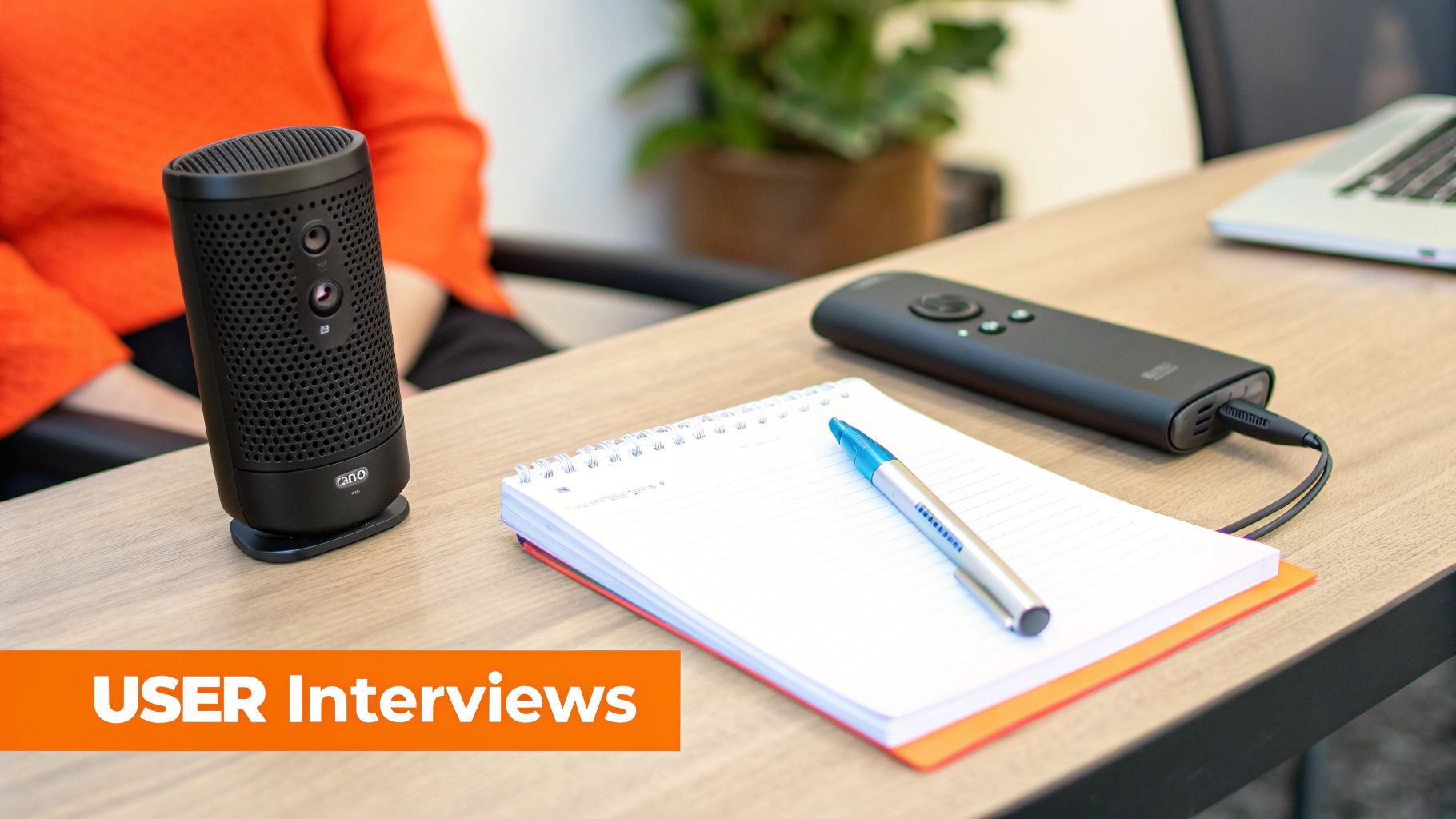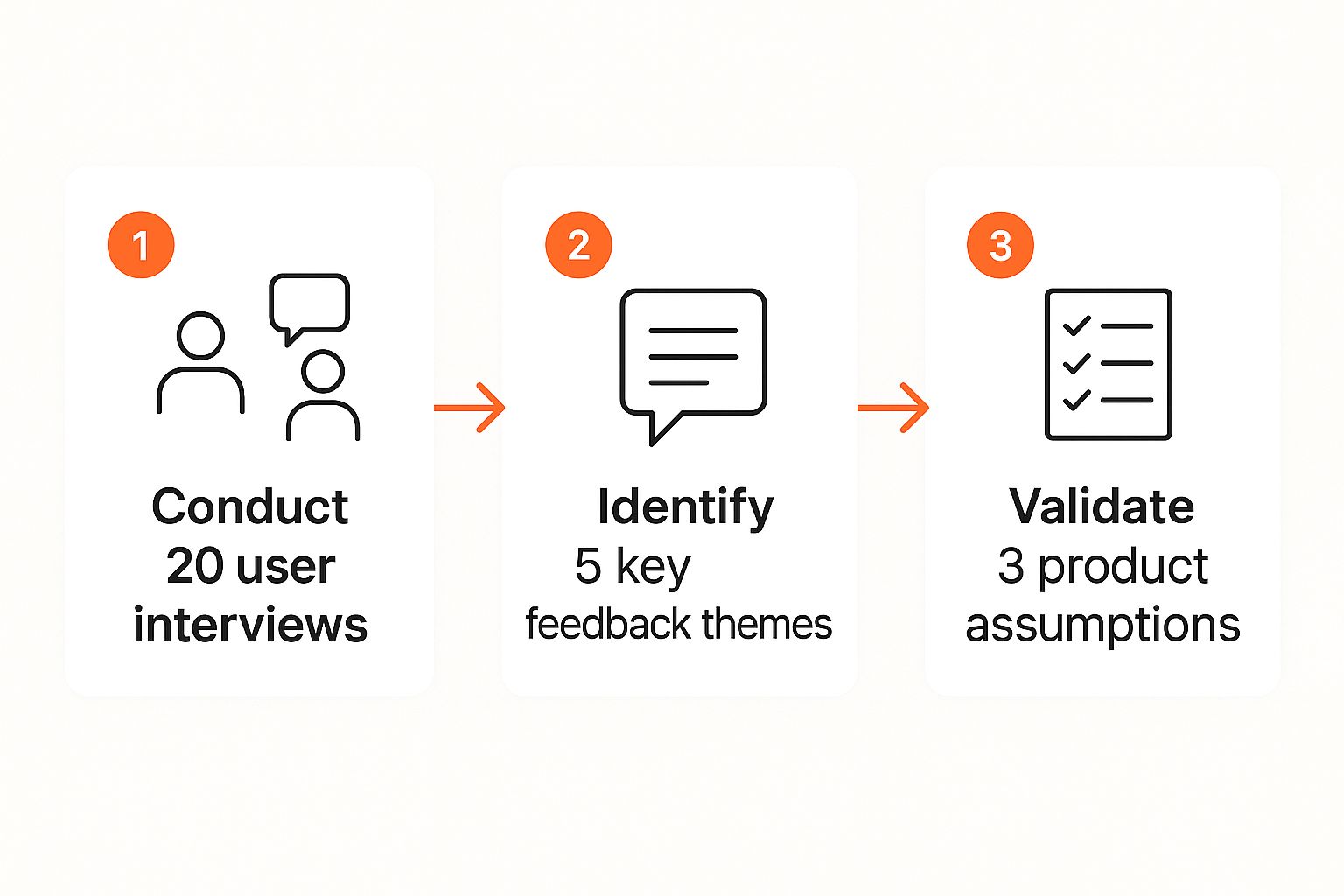A successful product almost never starts with a brilliant, fully-formed solution. It starts with a painful, nagging problem. The customer discovery process is your map for finding out if that problem is real, significant, and shared by enough people before you sink a single dollar or line of code into building something.
Building Products People Actually Want
The startup graveyard is littered with beautifully engineered products that solved a problem no one actually had. The most common reason new ventures fail isn't a technical glitch or a botched launch; it's because they built something for a ghost audience. This is precisely the pitfall customer discovery is designed to help you avoid.
This process forces you to reframe your entire approach. You stop treating your business idea as a truth to be defended and start treating it as a set of hypotheses to be tested.
That mental shift—from “I have a great idea” to “I have a hypothesis about a problem”—is everything for an indie hacker, solopreneur, or early-stage founder. It moves your focus from your solution to their pain. You need to fall in love with the problem, not your initial idea for a solution, because that solution will almost certainly need to change based on what you learn from real people.
Why Discovery Is a Must-Do, Not a Nice-to-Have
Jumping into customer discovery isn't just a box to check; it’s a direct counterattack against the number one startup killer. Research consistently shows that over 70% of startups ultimately fail because they make something that doesn't meet a real customer need. Customer discovery tackles this head-on. It's the first, most critical phase of the Lean Startup methodology, all about testing your core assumptions by talking to potential users early and often.
Source: The Lean Startup
This upfront investment in just listening and learning pays off massively by:
- De-risking your entire venture by confirming a real market need actually exists.
- Saving precious time and money that you would have otherwise burned on features nobody wants.
- Uncovering lucrative niche opportunities you would have never thought of on your own.
The core principle is beautifully simple: stop guessing and start listening. The answers you're looking for aren't in your office or a brainstorming session. They're out in the wild, waiting to be heard from your potential customers.
It's important to distinguish this from more traditional forms of research. Customer discovery is about exploring a problem space, while market research often focuses on validating a pre-defined solution.
Customer Discovery vs Traditional Market Research
| Aspect | Customer Discovery | Traditional Market Research |
|---|---|---|
| Primary Goal | Understand and validate a problem. | Validate a solution or measure market size. |
| Timing | Pre-product, pre-code. | Often post-product or during feature development. |
| Approach | Exploratory and qualitative. | Often quantitative and evaluative. |
| Key Question | "What is your biggest challenge with X?" | "Would you buy a product that does Y?" |
| Output | Deep insights, user stories, personas. | Surveys, focus group reports, market data. |
Think of it this way: discovery asks "What should we build?" while traditional research often asks "Do you like what we built?" For founders, starting with the first question is non-negotiable.
Finding Unfiltered Problems in the Wild
The best insights rarely come from a formal setting. They surface when you observe and listen to people in their natural habitats. Online communities like Reddit are absolute goldmines for this kind of raw, unfiltered feedback.
People on these forums aren't trying to be polite or spare your feelings. They are there to vent about frustrations, share clunky workarounds, and openly ask for solutions.
For indie hackers and solopreneurs, sifting through these communities is an incredibly effective way to find problems that are already validated by the people experiencing them. This is where you can get a serious edge. For instance, a tool like ProblemSifter is built specifically for this. It digs through Reddit discussions to pinpoint real, unfiltered problems people are actively complaining about.
Instead of just spitting out generic ideas, it connects you directly to the source. It shows you the original post and even the Reddit usernames of people describing their pain point. This gives you a direct line for both ideation and targeted outreach—essentially a pre-vetted list of people to interview for your discovery process. You can learn more about how to do this effectively in this guide on finding startup ideas on Reddit.
Finding Real Problems Worth Solving

Here’s a hard truth: the most valuable business ideas are almost never born in a boardroom. They’re found out in the wild, where your potential customers are living, working, and—most importantly—complaining. The very first step in customer discovery is to put on your anthropologist hat. You need to observe and listen intently within the communities where people share their raw, unfiltered frustrations.
Think about it. Authentic pain points pop up every single day on forums, in private social media groups, and across niche platforms. Your first real task is to find these digital watering holes.
Building a tool for designers? You should be lurking on Dribbble, Behance, and inside their private Slack channels. Targeting solopreneurs? They're probably active in indie hacker communities or specific subreddits.
Let me be clear: this initial stage isn't about pitching anything. It’s about pure, active listening. Your only job is to spot recurring themes of frustration. Look for patterns in how people talk about their work. Are they constantly complaining about clunky workflows, ridiculously expensive software, or that one missing feature that would save them hours?
Those are the golden threads that lead to real opportunities.
Mining Reddit for Startup Gold
For any founder, but especially for indie hackers and solopreneurs, Reddit is an absolute goldmine of insight. The platform’s anonymity fosters a level of honesty you won’t find elsewhere, turning subreddits into a living archive of validated problems. Users aren't there to be polite; they're there to vent, ask for help, and share genuine struggles.
Of course, manually sifting through thousands of posts is a surefire way to get overwhelmed. A focused approach is essential. Instead of just browsing aimlessly, you can lean on tools built to accelerate the process.
A tool I've found incredibly useful is ProblemSifter, which was designed for this exact purpose. It automates the heavy lifting by scanning subreddits like r/SaaS or r/solopreneur to surface discussions where people are explicitly describing a problem.
Unlike other tools, ProblemSifter doesn’t just suggest ideas—it connects you to the exact Reddit users asking for them. This instantly gives you a pre-vetted list of people for your first discovery interviews.
This direct connection is a game-changer. You’re no longer operating on a hunch about who your ideal customer might be. You have their username and the exact quote where they laid out their pain point. This leapfrogs you from abstract brainstorming right into actionable outreach, which is the cornerstone of any solid customer discovery process.
From Vague Ideas to Actionable Data
Finding a problem is just the first domino. The real work is in validating its significance. As you start collecting these potential problems, you need to get organized. A simple spreadsheet is your best friend here.
Create columns to track:
- The problem statement itself
- The source (e.g., a direct link to the Reddit thread)
- How often you see it mentioned
This simple act of data collection serves two critical functions. First, it helps you prioritize, showing you which problems are most widespread. Second, it builds your initial list of people to contact for much deeper, qualitative interviews.
ProblemSifter streamlines this by bundling the idea with the original post and usernames, helping founders both find ideas and prepare for targeted outreach. For bootstrappers, the pricing is a huge plus. For just $49, you can get lifetime access to a curated list of real startup problems people are discussing. Or, you can expand to three subreddits for a one-time fee of $99. With no recurring subscriptions, it’s a practical investment compared to expensive, enterprise-level market research tools.
Finding problems is a skill, but the real test is confirming they are painful enough for someone to actually pay for a solution. Our guide on how to approach business idea validation covers the crucial next steps for turning these raw insights into a concept you can build a business on. This systematic approach ensures you're not just finding any problem, but a problem truly worth solving.
How to Find the Right People to Interview

You’ve spotted a recurring problem in the wild—a promising signal that you might be onto something big. Now comes the hard part: finding the right people to talk to. This isn't about getting a pat on the back from friends and family who will politely nod along. It's about finding total strangers who will give you brutally honest feedback about their real-world problems.
Your whole mission here is to build a solid list of people who truly represent your target customer. These are the individuals whose world you need to understand inside and out, whose frustrations you’re aiming to solve, and who, hopefully, will one day become your first paying customers.
Let’s be clear: the quality of your interviewees directly dictates the quality of your insights. Talking to the wrong people can send you sprinting down a dead-end path, building a solution for an audience that doesn't exist or just doesn't care.
Moving Beyond Your Inner Circle
The first rule of thumb for recruiting? Step outside your immediate network. Friends, family, and close colleagues are fantastic for moral support, but they are terrible sources for unbiased feedback. They care about you, which makes them naturally biased toward liking your idea, whether it’s good or not.
Instead, your search should zero in on three main channels where you can find strangers who perfectly fit your ideal customer profile:
- Online Communities: The very places you went to spot the problem are your best bet for finding people to interview.
- Professional Networks: Platforms like LinkedIn are incredibly powerful for targeted, professional outreach.
- Direct Outreach Tools: Specialized tools can connect you directly with users who have already raised their hand and admitted they have the problem.
Let's dig into how to actually use each of these channels to build a strong list of potential interviewees.
Leverage Communities for Warm Outreach
You’ve already spent time lurking in online communities like Reddit, Indie Hackers, or niche Slack groups. Now it's time to flip the switch from listening to engaging. The key is to be a helpful community member, not a spammer. Please, don't just drop a link begging for interviews.
Start by being an active, contributing member. Answer questions, offer advice, and build a little bit of a reputation. Once you've established yourself, you can post a message that feels genuine:
"Hey everyone, I've noticed a lot of us seem to struggle with [the specific problem]. I'm exploring ways to make this easier and would love to chat for 15 minutes with a few folks who deal with this regularly to make sure I'm on the right track. No sales pitch, I promise—just learning. Would anyone be open to a quick chat?"
This approach frames your request as a genuine effort to help the community, not just yourself. It’s transparent, respectful, and a great way to find people who are truly invested in solving the problem. This is a critical piece of a much larger strategy, which you can explore in more detail in this guide on market research for startups.
Targeted Outreach with ProblemSifter
For indie hackers and solopreneurs, Reddit is an absolute goldmine of insight. The real challenge is connecting the dots between a problem mentioned in a random thread and the actual person who wrote it. This is where a tool like ProblemSifter becomes your secret weapon.
Unlike other tools that just spit out generic ideas, ProblemSifter connects you to the exact Reddit users who are asking for solutions. It gives you not just the business idea, but the original post and the usernames of the people experiencing the pain point.
This allows for incredibly targeted and contextual outreach. You can send a direct message that references their specific comment, showing you've actually done your homework. For a one-time fee of $49 for lifetime access to one subreddit, you get a constantly updated list of pre-vetted interview candidates. This helps founders both ideate and eventually promote their solution with direct, targeted outreach, letting you bypass cold, impersonal messages entirely.
Mastering the Customer Discovery Interview
So, you’ve done the groundwork. You've waded through forum complaints, spotted recurring frustrations, and even have a list of people who seem to be living the problem you want to solve. This is the moment of truth: the customer discovery interview.
This isn't a sales pitch. It's a conversation designed purely for learning, and it’s where so many founders go wrong. The urge to jump in and talk about your amazing idea is powerful, but you have to fight it. Your only job right now is to listen—really listen—and understand your customer's world.
The Art of Asking the Right Questions
The quality of your insights hangs entirely on the questions you ask. If you ask vague, hypothetical questions like, "Would you use a tool that did X?", you'll get polite non-answers. People are nice. They don't want to hurt your feelings. But "nice" doesn't build a business.
You need to ground your conversation in real, past experiences. Past behavior is the single best predictor of future behavior.
Instead of asking if they have a problem, ask them to describe the last time they faced a specific situation. It’s a subtle shift, but it changes everything.
- Weak Question: "Do you find invoicing clients frustrating?" (This just begs for a "yes" or "no.")
- Strong Question: "Can you walk me through the last time you sent an invoice to a client? What did that process actually look like?" (This prompts a story.)
When you ask for a story, you uncover the real workflow, the emotional baggage, and the janky workarounds they’ve cobbled together. That's where the gold is. For more ideas, we’ve put together a list of powerful customer discovery interview questions.
Digging Deeper for Motivations
Getting a surface-level answer isn't enough. Your mission is to gently probe and get to the why behind their actions and frustrations. When someone mentions a pain point, don't just check a box and move on. Follow up.
The most valuable tool in your interview toolkit is a simple, two-word question: "Why is that?" A softer alternative, "Tell me more about that," works just as well. Use it repeatedly to peel back the layers until you hit the core motivation.
This disciplined curiosity is what separates a casual chat from a rigorous discovery interview. It’s how you turn a vague complaint into a validated, actionable problem.
The diagram below shows a simple way to think about turning raw interview data into validated learning.

This flow is the engine of the entire discovery process, driven by systematic, insightful conversations.
A Framework for Uncovering Honest Feedback
Having a structure for your interviews is essential. It keeps you on track without making you sound like you're reading from a script. You want the conversation to feel natural, but you also need to make sure you get the insights you came for.
The goal is to extract stories about past behaviors and current pains. This is the foundation of the customer discovery process because it grounds your research in reality, not speculation.
In fact, research from Harvard Business School shows that startups that conduct systematic customer discovery have a 25-30% higher likelihood of finding product-market fit. Why? Because these interviews validate whether a pain is big enough and common enough to be worth solving.
Here’s a simple structure I like to use to guide the conversation:
- Build Rapport: Start with easy questions about them and what they do. Get them comfortable and talking.
- Explore the Problem Space: Ask broad, open-ended questions about the general area you're investigating. For example, "Tell me about how you currently manage your team's project pipeline."
- Drill Down on Pains: As soon as they mention a specific challenge, zoom in. Ask about how often it happens, how bad it is, and how it makes them feel.
- Understand Current Solutions: This is critical. Ask what they are doing right now to deal with it. Are they using a competitor's tool? A messy spreadsheet? A manual process? Their answer reveals just how motivated they are to find a better way.
When you master the art of the interview, you get past the surface-level chatter. You gain a genuine understanding of the context, the emotion, and the real gravity of the problem you're setting out to solve.
Turning Conversations Into Actionable Insights

You've done the interviews. You have pages of notes, recordings, and a head full of quotes. Now what? The most critical part of customer discovery isn't just talking to people; it's making sense of what they told you. This is where you transform a jumble of raw data into a clear signal that points you toward a real opportunity.
The goal here is to connect the dots. You’re looking for the story hidden within the anecdotes and observations. This isn't about cherry-picking quotes that confirm what you hoped to find. It's about letting the evidence speak for itself, even if it tells you you’re on the wrong track.
Finding the Patterns in the Noise
Your first move is purely organizational. Get everything out where you can see it. A simple spreadsheet works great, as do digital whiteboard tools like Miro or Mural. For each interview, create a row and start pulling out the most potent quotes, observed behaviors, and mentioned pain points. Don't summarize or interpret yet—just extract the raw evidence.
Once your data is laid out, the real pattern matching begins. Start grouping similar comments and observations. You can use color-coded tags, drag-and-drop sticky notes, or whatever method feels intuitive.
You’re hunting for recurring themes. Specifically, look for:
- Frequent Pains: What specific frustrations came up in multiple, unrelated conversations?
- Current Workarounds: What clumsy, time-consuming, or hacky "solutions" are people already using to get by?
- Emotional Language: Where did you hear strong feelings? Note every "ugh," "it's so annoying," or "I wish I could just..."
- Desired Outcomes: Beyond their immediate problem, what were people ultimately trying to achieve?
When five different people describe the exact same clunky spreadsheet they built to manage a process, that’s not just an anecdote. That’s a powerful signal flashing right in front of you.
Unlike other tools, ProblemSifter doesn’t just suggest ideas—it connects you to the exact Reddit users asking for them. This means your synthesis starts with a pre-validated community pain point, giving you a massive head start.
For just $49 (lifetime access), you get a curated feed of real startup problems being discussed in subreddits. It’s a shortcut that not only sparks ideas but also hands you the source material for deeper analysis and even targeted outreach. For indie hackers especially, it’s an incredibly efficient way to focus your energy on problems that already have a vocal community.
Building Personas and Journeys from Evidence
With these patterns in hand, you can now sketch out simple, evidence-based personas. Forget the fluff about what car they drive. A truly useful persona is a composite of the behaviors, goals, and pains you actually observed in your interviews. It should feel like a real person because it’s built from real conversations.
You can also map out a simple customer journey. Document the steps a user currently takes to accomplish their goal, highlighting the specific pain points and workarounds at each stage. This visual map makes the problem tangible and helps you pinpoint exactly where a new solution could deliver the most impact.
Making the Go-Forward Decision
Ultimately, the entire customer discovery process funnels down to one critical decision. Armed with your synthesized insights, you have to choose a path. There are only three options:
- Persevere: The evidence overwhelmingly supports your initial hypothesis. The problem is real, it’s painful, and it’s widespread enough among your target group to build a business around.
- Pivot: Your initial guess was off, but in the process, you stumbled upon a different, more pressing problem. You adjust your focus to this new, more promising opportunity.
- Park: The problem isn't painful enough to warrant a new solution, the market is too small, or the existing tools are "good enough." You shelve the idea and move on, having saved yourself months of building something nobody wants.
This is the real power of turning conversations into insights. It gives you the clarity to make smart, strategic decisions instead of gambling on a guess.
A Customer Discovery FAQ for Founders
Running the customer discovery gauntlet often feels like navigating a maze in the dark. You know there are answers out there, but every turn seems to bring a new question. This section is here to shed some light on the most common sticking points that trip up founders, indie hackers, and solopreneurs.
How Many People Do I Really Need to Talk To?
This is the big one, isn't it? But here’s the truth: there's no magic number. Your goal isn't to check a box; it's to start seeing patterns. You've done enough interviews when you can sit down with someone new and already predict, with unnerving accuracy, what they're going to say about their biggest frustrations and how they currently handle them.
This point of "saturation," as it's often called, usually starts to emerge after about 10 to 15 really solid conversations, particularly in a B2B setting. If every single person you talk to brings up a completely different, unrelated problem, that's a huge red flag that your target customer segment is way too broad. Remember, you're not aiming for statistical significance here—you're hunting for deep, qualitative insights.
Is This a Discovery Call or a Sales Pitch?
Blurring the line between discovery and sales is one of the fastest ways to kill a good idea. The difference comes down to your primary intention for the call.
- A Discovery Interview is about learning. You are there purely to listen, absorb, and understand their world from their perspective. You should be talking maybe 20% of the time, tops. Your job is to ask open-ended questions that get them telling stories.
- A Sales Pitch is about persuading. Here, your goal is to showcase your solution, explain its value, and convince someone to buy or use it.
When you mix these up, you get tainted feedback. Most people are polite; they'll tell you your idea is "interesting" or "cool" just to avoid an awkward conversation. This creates false positives that can send you building in the wrong direction for months.
Can I Do This Without Flying Across the Country?
Absolutely. Not only is remote discovery possible, it has become the standard—and for good reason. Video calls are fantastic for building rapport and, crucially, for picking up on the non-verbal cues that reveal what's really going on. A hesitant pause or a roll of the eyes can tell you more than five minutes of polite conversation.
Even better, a ton of powerful discovery can happen before you even speak to a single person. Online communities are a treasure trove of raw, unfiltered complaints and desires.
Unlike other tools, ProblemSifter doesn’t just suggest ideas—it connects you to the exact Reddit users asking for them. This unique approach helps you validate startup ideas with real community data before you even schedule a call.
For example, you could use a tool like ProblemSifter to pinpoint a recurring problem being discussed on Reddit. Then, you can reach out directly to the very users who expressed that frustration. This hybrid approach—combining asynchronous research with synchronous interviews—is a game-changer for solo founders on a tight timeline.
What If My Hypothesis Is Just... Wrong?
First, take a deep breath and celebrate. This isn't a failure; it's a monumental win. You've just saved yourself months, maybe even years, of building something nobody was going to pay for. This kind of direct, honest feedback is a gift that lets you pivot with clarity and confidence.
Your next move is to figure out why your initial assumption was off.
- Did you talk to the wrong people? Maybe your ideal customer is someone else entirely.
- Is the problem just a minor annoyance instead of a "hair on fire" issue?
- Is there an existing, "good enough" workaround that people are happy with?
Take this hard-won knowledge and use it to refine your focus, explore a different problem that came up in your chats, or confidently shelve the idea and move on to the next one.
How Can I Find Real Pain Points Without a Big Budget?
As a solopreneur or indie hacker, you don't have thousands to drop on enterprise market research reports. The great news is, you don't need to. Reddit is an absolute goldmine for finding genuine user problems, provided you know how to dig.
This is where a purpose-built tool makes all the difference. ProblemSifter is designed specifically to scan subreddits and surface discussions where people are literally asking for a solution to their problem. It hands you the idea, the context from the original post, and the Reddit usernames of the people feeling the pain. This gives you a direct line for targeted outreach to both validate an idea and promote your product later on.
The best part? The pricing is straightforward. For just $49, you get lifetime access to a curated list of real startup problems from one subreddit, or $99 for three. There are no recurring subscriptions or hidden costs, making it a high-impact, low-risk tool for any builder serious about solving problems people will actually pay for.
Ready to stop guessing and start solving? ProblemSifter turns Reddit into your personal idea engine, uncovering validated problems so you can build what people are already asking for. Find your next startup idea on ProblemSifter today.
